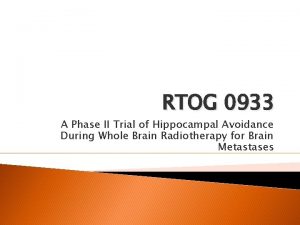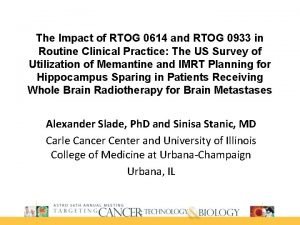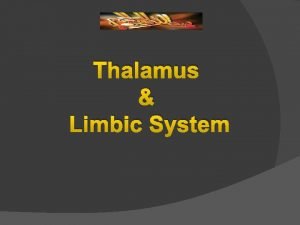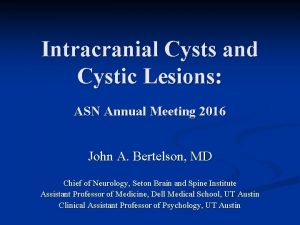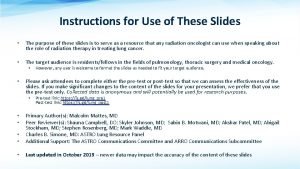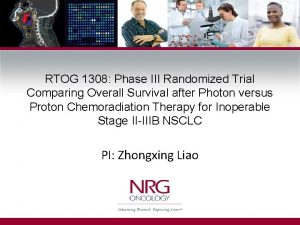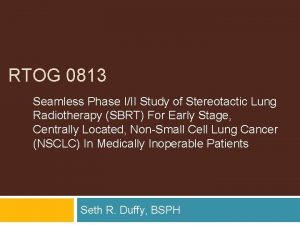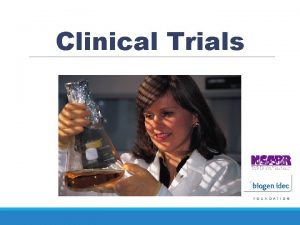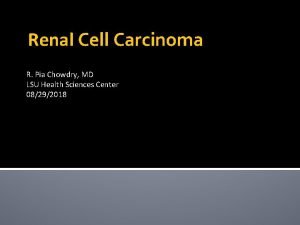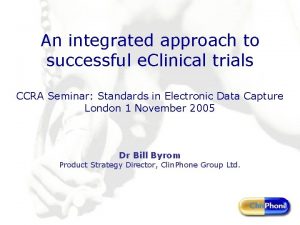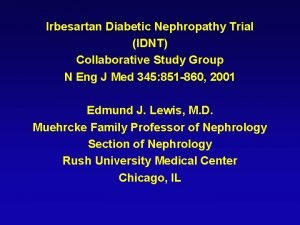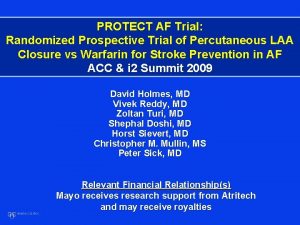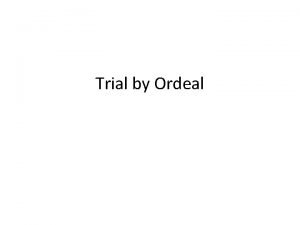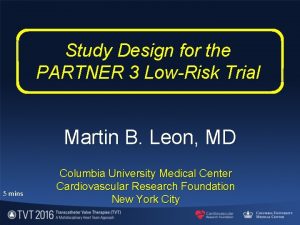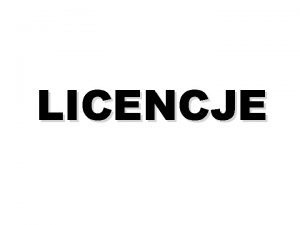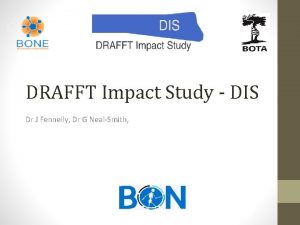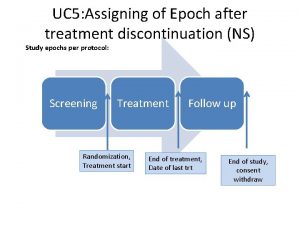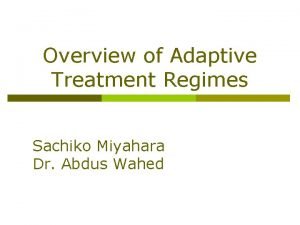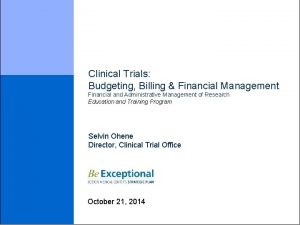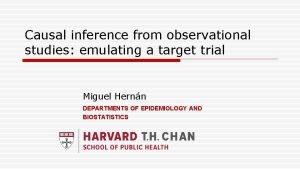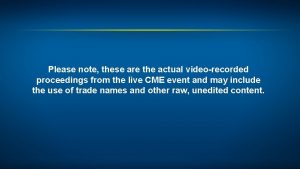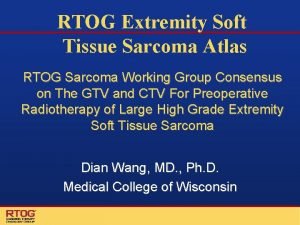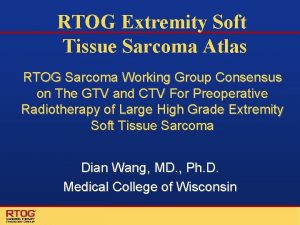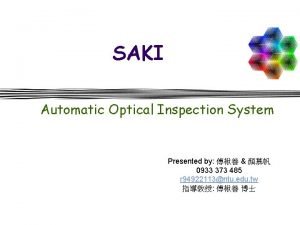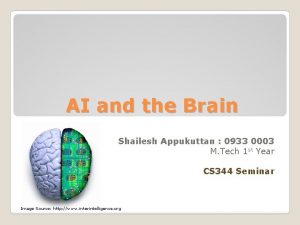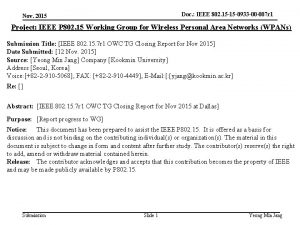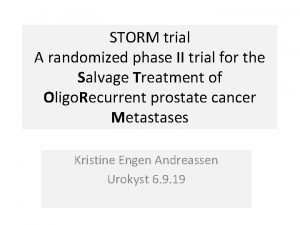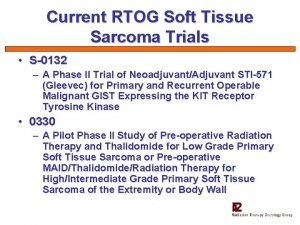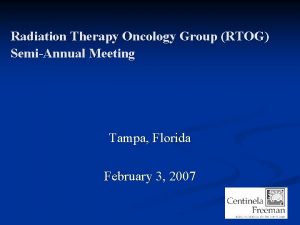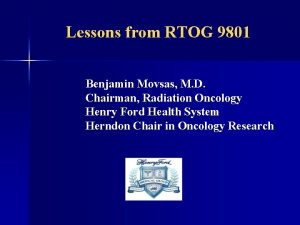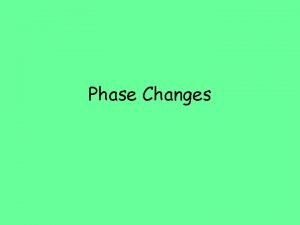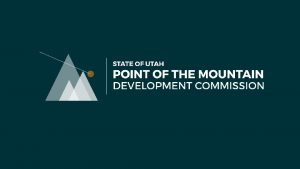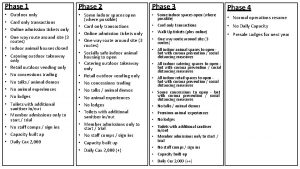RTOG 0933 A Phase II Trial of Hippocampal




































- Slides: 36

RTOG 0933 A Phase II Trial of Hippocampal Avoidance During Whole Brain Radiotherapy for Brain Metastases

The Purpose � To determine any good or bad effects that avoiding the hippocampus has on memory

RTOG 0933 � Radiation Therapy Oncology Group (RTOG) ◦ NCI-funded clinical trial organization � Protocol Finalized December 5, 2011 � Accrued 113 patients � CLOSED November 7, 2012

The Hope � The hippocampus is important for memory � The hope is that avoiding it will decrease memory loss and reduce deterioration of thinking ability after whole brain therapy � Currently no proof that this will happen

Background

Why Whole Brain RT? � Rapid � Can palliation of symptoms delay NCF decline � Might also cause NCF decline ◦ 1 -4 months memory effects � Unclear: � Still confounding effects of mets standard technique for brain mets

The Hippocampus 2. 1. 3. 1. Hippocampus. Neurology Channel Website. http: //thebrainlabs. com/Images/hippocampus. gif. Accessed June 30, 2015. 2. Mayer KC. Hippocampus. Neuro 24 Website. http: //www. neuro 24. de/hip 0006. jpg. Accessed June 30, 2015 3. Hippocampus. Wikipedia Website. https: //upload. wikimedia. org/wikipedia/commons/5/5 b/Hippocampus_and_seahorse_cropped. JPG. Updated June 21, 2015. Accessed June 30, 2015.

Hippocampus Sensitivity � Neuronal progenitor cells could be damaged ◦ Radiation may cause apoptosis � Inflammation interferes with stem cell differentiation � Still not 100% clear in human model

Credentialing http: //winnipeghonda. ca/wp-content/uploads/2015/01/check. png

Facility Credentialing � General IMRT planning � Hippocampus contouring � Protocol-specific � Neurocognitive HA whole brain planning test administration

Trust But Verify � Plans will be sent to central review board � Plans returned with feedback in <3 days ◦ Check of hippocampus contours ◦ Check of plan parameters � Treatment may commence once satisfied

Patient Selection

Patient Selection � General characteristics � Histology � Brain condition � General health � Concurrent treatments � Tumor location

General Patient Characteristics � Age > 18 � Can tolerate MRI � Not pregnant ◦ No magnetic metal ◦ No claustrophobia ◦ Will not become pregnant � Speaks English ◦ Has signed a consent form

Histology � Brain lesion must be metastasis ◦ Must have proof of other malignancy within 5 years � Can not be: ◦ Hematopoietic malignancy ◦ Germ cell malignancy ◦ Small cell lung cancer

Brain Condition � No leptomeningeal mets � No hydrocephalus D E prior brain surgery � No biopsy within 1 week T C E � No prior brain radiation � No history of SRS R J E Schizencephaly. Image of the Week Website. http: //www. bimjonline. com/Imageoftheweek/Imagewk 29(19 -11 -2012). htm. Published 2012. Accessed June 30, 2015.

Patient Health � H&P performed within 30 days � Karnofsky � No Performance Score >= 70 heart issues within 6 months � No severe liver issues � No severe respiratory issues � No major bacterial infections

Concurrent Treatments � Disqualifiers: ◦ Concurrent chemo (or within 1 week after) ◦ Treatment involves surgery ◦ Treatment involves SRS

Tumor Location � Can not be within 5 mm of either hippocampus � (that’s about it)

Getting started

Patient Workup � Imaging: ◦ Recent MRI ◦ CT Simulation � Neurocognitive � Quality Function Test of Life Assessment

MRI Requirements � MRI within 30 days prior to registration � Sequences ◦ T 1 with gadolinium ◦ T 2 � 1. 5 ◦ ◦ SPGR MP-RAGE TFE FLAIR mm maximum slice thickness

CT Requirements � Non-contrast � Entire � 2. 5 head region mm maximum slice thickness

Neurocognitive Test � Immediate recall � Immediate recognition ◦ Repeat a list of words ◦ Identify words that were in the list � Delayed recall (after 20 mins) ◦ Recall prior words

Quality of Life Survey � Examines feelings of well-being ◦ Physical ◦ Social ◦ Emotional ◦ Functional

Making a Plan

Contouring � Standard optics ◦ Lenses, eyes, optic nerves, chiasm � Hippocampus � HA: Hippocampal Avoidance ◦ 5 mm expansion of Hippocampus � CTV: Brain to C 1 or C 2 � PTV: CTV minus HA

Fusion � MR(s) should be fused to planning CT ◦ Should use semi-automatic technique � Ideally MR was acquired in nearly same plane angle as CT

Dose & Fractionation � 30 Gy in 10 fx � Daily, � PTV 5 x per week D 90% > Rx (30 Gy) D 2% < 37. 5 Gy � PTV D 98% > 25 Gy

Planning: Tomotherapy � Specific machine parameters ◦ Field width, pitch, modulation factor � Selected ◦ PTV plan constraints: �Max < 30 Gy �V 30 Gy > 96% ◦ Hippocampus �Max < 6 gy �V 3 Gy < 20%

Planning: Linac � 2 Choices of 9 -Beam Arrangement ◦ Specific couch and gantry positions ◦ Non-coplanar � Selected ◦ PTV plan constraints: �Max < 34 Gy �Min > 32 Gy ◦ Hippocampus �Max < 11 Gy �V 9 Gy < 40%

Followup Telephone. DCHoos Website. http: //dchoos. org/wp-content/resources/telephone. jpg Uploaded December 12, 2011. Accessed June 30, 2015.

Followup After Treatment � Every 2 months for 6 months ◦ (every 3 months after that) ◦ Physical exam ◦ MRI of the brain ◦ 20 minute Cognitive Test �(Extra tests at 2, 4, and 12 months)

Benefits to Patients � If hypothesis is true, fewer memory and cognitive problems after whole brain RT ◦ Better quality of life ◦ Less dependence on caretakers � Who benefits? ◦ Brain is a common site of metastasis ◦ Whole brain RT is sometimes prophylactic

Benefits to Organizations � Better outcomes for patients ◦ Less follow-up care � Competitive advantage?

Thank you
 Rtog 0933
Rtog 0933 Rtog 0933
Rtog 0933 Purpose of the thalamus
Purpose of the thalamus Hippocampal sulcus remnant cysts
Hippocampal sulcus remnant cysts Rtog 0813
Rtog 0813 Rtog 1308
Rtog 1308 Rtog 0813
Rtog 0813 Rtog 3507
Rtog 3507 Clinical trial timeline
Clinical trial timeline Difference between phase voltage and line voltage
Difference between phase voltage and line voltage Detectors used in hplc
Detectors used in hplc Mobile phase and stationary phase
Mobile phase and stationary phase In a triangle connected source feeding a y connected load
In a triangle connected source feeding a y connected load Stationary phase and mobile phase in hplc
Stationary phase and mobile phase in hplc Normal phase vs reverse phase chromatography
Normal phase vs reverse phase chromatography Broad phase vs narrow phase
Broad phase vs narrow phase Normal phase vs reverse phase chromatography
Normal phase vs reverse phase chromatography Tswett pronunciation
Tswett pronunciation Cabosun trial nejm
Cabosun trial nejm Iwr clinical trials
Iwr clinical trials Idnt trial
Idnt trial Protect af trial
Protect af trial Trial by ordeal definition
Trial by ordeal definition N100ta
N100ta The adjusting process
The adjusting process Licencja co to jest
Licencja co to jest Drafft
Drafft Oregon trial
Oregon trial Trial elements sdtm
Trial elements sdtm Percentage of criminal cases that go to trial
Percentage of criminal cases that go to trial Star d trial
Star d trial Meaning of trial
Meaning of trial Clinical trial financial management
Clinical trial financial management Target trial emulation
Target trial emulation Overview of accounting process
Overview of accounting process Judicial restraint clipart
Judicial restraint clipart Polarix trial
Polarix trial
